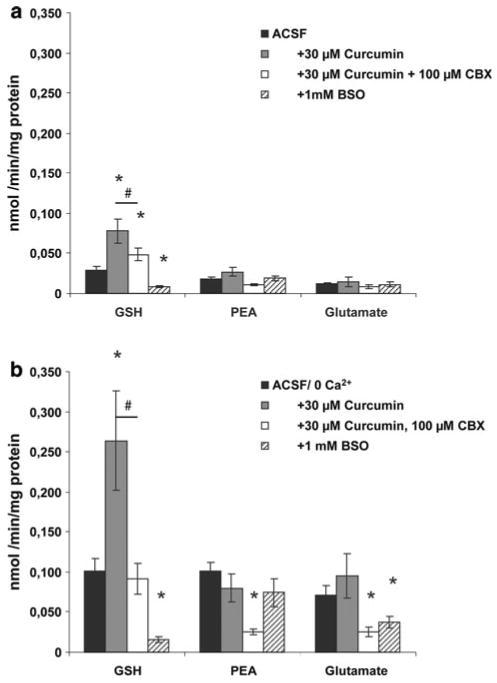Fig. 4.

a Effects on efflux of GSH, phosphoethanolamine (PEA) and glutamate (Glu) in ACSF after treatment of the astrocyte cultures for 24 h with 30 μM curcumin or 1 mM buthionine sulfoximine (BSO). The efflux of GSH in ACSF was decreased by treatment for 24 h with BSO and increased by treatment with curcumin. The increased basal efflux of GSH in ACSF was decreased by the gap junction inhibitor carbenoxolone (CBX). No significant effects were observed for efflux of PEA or Glu. Stars mark significant different efflux (p < 0.05) by treatment for 24 h compared to no treatment. # marks significant difference between curcumin treated samples with or without carbenoxolone. b Effects on efflux of GSH, phosphoethanolamine (PEA) and glutamate (Glu) in ACSF/ 0 Ca2+ after treatment of the astrocyte cultures for 24 h with 30 μM curcumin or 1 mM buthionine sulfoximine (BSO). The stimulated efflux of GSH was decreased by treatment for 24 h with BSO and increased by treatment with curcumin. The gap junction blocker carbenoxolone (CBX) reduced the enhanced stimulated efflux of GSH in curcumin treated cultures. No significant effects by treatment with curcumin were observed on efflux of PEA or Glu in ACSF/0 Ca2+. The stimulated efflux of PEA and Glu were reduced by CBX (only evaluated in curcumin treated slices). The stimulated efflux of Glu was reduced after treatment of the cultures with BSO for 24 h. Data are presented as mean efflux rate (n = 6 ± SEM). Stars mark a significant difference (p < 0.05) in efflux with inhibitors or treatment compared to efflux in ACSF/0 Ca2+ without inhibitors. # marks significant difference between curcumin treated samples with or without carbenoxolone
